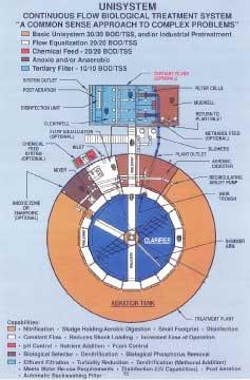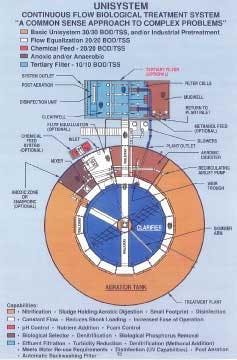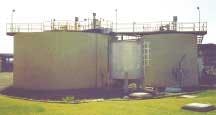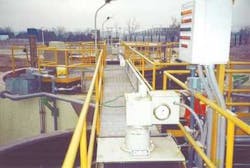Value Added Wastewater Treatment: Chilean Beverage Plant Benefits from Biological Process
By Cheri Cohen
Customized treatment technologies are dispelling the notion that wastewater treatment is synonymous with flushing profits down the drain. Pretreatment helps companies avoid or eliminate surcharges. And practicing good environmental stewardship reaps even greater rewards. Wastewater treatment does add value.
As environmental regulations have become stricter in many countries, municipalities are assessing high fines to industrial dischargers who are out of compliance. That's because some municipalities are having trouble handling the load on their water and wastewater treatment systems. Hence, companies opt to install or upgrade their own treatment facilities altogether, enjoying a greater economic payback on such projects.
Among biological treatment systems, the Unisystem® high-rate activated-sludge process' custom design versatility uniquely fulfills many needed treatment requirements into a single package customized to a plant's needs. Developed by Aeration Industries International Inc, the continuous-flow system can be configured for low flow rates or a higher flow rate in either rectangular box or circular configuration.
Customized Beverage Plant
Coca-Cola de Chile S.A. chose this activated-sludge wastewater treatment system for its concentrate operations plant in Santiago, Chile. The Santiago operation produces concentrates and beverage bases for distribution to independent Chilean bottlers.
The Coca-Cola Company is environmentally conscious and employs a "good neighbor" policy worldwide. This project was the result of a close partnership between Coca-Cola's corporate headquarters in Atlanta, Ga., and Parsons Engineering teaming up with Aeration Industries to produce the most efficient and cost effective plant design.
As in many countries, environmental regulations exist in Chile for wastewater pre-treatment limits at beverage plants. The discharge regulations, however, were more liberal than the discharge standards developed by the Coca-Cola Co. that state minimally all plants discharging into natural bodies of water install systems so that final discharge is capable of supporting fish life (50 ppm BOD). This was demonstrated with the provision for construction of a fish pond into the wastewater treatment system.
Operational Parameters
The Unisystem provides wastewater BOD, COD and suspended solids reduction. The system also offers advanced treatment processes such as biological nitrification/denitrification, phosphorus removal, pH adjustment and disinfection, depending on wastewater process requirements.
Denitrification can be accomplished with the addition of an anaerobic and/ or an anoxic section, with the appropriate recycle, to its basic wastewater treatment plant setup. At times and with certain industrial wastewater, the use of either anaerobic or anoxic zones will serve as a biological selector. Sometimes these processes are essential for developing a biological growth that settles rapidly and compactly in the integral final clarifier. With the soluble BOD metabolized in the basic system, it can be fitted with an automatic backwashing tertiary filter to control the effluent suspended solids level down to as low as 5 mg/L.
In total, this biological treatment system can incorporate many unit processes in one system for both domestic and industrial wastewaters. It's compact, self-contained and ready for above or below-ground installation with a minimum of expense. Relatively small in size and operating odor free, they can be installed in a variety of locations.
Meeting the Challenge
The Santiago plant's washdown activities and disposal of product generated 9,508 to 11,359 gallons per day wastewater flow (36 m3/day - 43 m3/day). Influent COD averaged 1,607 mg/L with TSS at 88 mg/L and pH range varying from 2-11.
The solution provided here consisted of a packaged treatment system that included influent submersible pumps and the following processes: aerobic treatment, secondary settling/clarification, chlorination, and aerobic sludge digestion. Digested sludge is combined with sludge from process treatment, stabilized with lime prior to dewatering on a filter press.
Raw wastewater flows from a concrete below grade pumping station into a neutralization/equalization tank. The equalization tank stores wastewater that flows to the tank during a 40-hour period each week. Outflow, though, is over 168 hours per week to ensure that the microorganisms in the biological treatment systems that follow will have a constant supply of food to promote growth.
The biological roughing tower provides the first stage of biological treatment. The second stage of biological treatment consists of activated sludge treatment. Both stages ensure meeting effluent discharge criteria. The wastewater and microorganisms then flow to a secondary clarifier to allow the microorganisms to be separated from the flow and returned via an underflow pump to the aeration system. Clear liquid effluent overflows from the clarifier and flows into the color removal and filtration systems.
Chlorination and dechlorination tanks serve to remove color from the effluent from the biological treatment system. This is followed by a sand filtration system that serves to remove residual solids not removed by the clarifier. Effluent from the dechlorination tank flows though a fish pond and into the existing municipal sewer system. The fish pond is intended to demonstrate the treatment effectiveness.
The Final Step
The final treatment process involves the stabilization and dewatering of wastewater treatment residuals. The sludge, once stabilized, will be suitable for land application in agricultural areas.
The 3,300 gallon (12.5 m3) below grade concrete fish pond has a water depth of one meter and was supplied with vegetative landscaping around its perimeter. An architectural fountain, sand filter pumps, and supplemental aeration are supplied to maintain adequate dissolved oxygen for the fish. Treated effluent discharges by gravity to the municipal sewer.
The effluent discharge characteristics are BOD/TSS 50 mg/L while pH range equals 6.5 to 8.5.
After the plant was commissioned and placed on line, Aeration Industries vice president of technical sales Bill Randall and the company's Chilean representative met with the president of the Santiago facility who was pleased with the system's performance. "The president stated 'the Chilean EPA authorities told us that it is one of the most efficient and highest quality plants in Chile,'" said Gonzalo Hurtado, president of Manantial of Santiago, Chile, Aeration Industries' Chilean representative.
Conclusion
Coca-Cola de Chile S.A. chose to install its own treatment facilities with the Unisystem package treatment plant and as a result enjoys greater payback in terms of community goodwill – due to elimination of unpleasant odors – and a reputation as a steward for the environment. Plus, everyone sleeps at night with no worries of fines or surcharges. That's added value!
About the Author: Cheri Cohen is vice president of marketing and public relations for Aeration Industries International Inc., of Chaska, Minn., near Minneapolis. Founded in 1974, Aeration Industries offers a full product line of environmental equipment and systems for wastewater treatment including its customized treatment plants, oxidation ovals, aerator/mixers, aerators and a dispersed air flotation system for physical/chemical pre-treatment and separation of fats, oils and grease. With over 20 years with the company, Cohen holds a bachelor's degree from the University of Minnesota. She can be contacted at 952-448-6789, [email protected] or www.aireo2.com.



